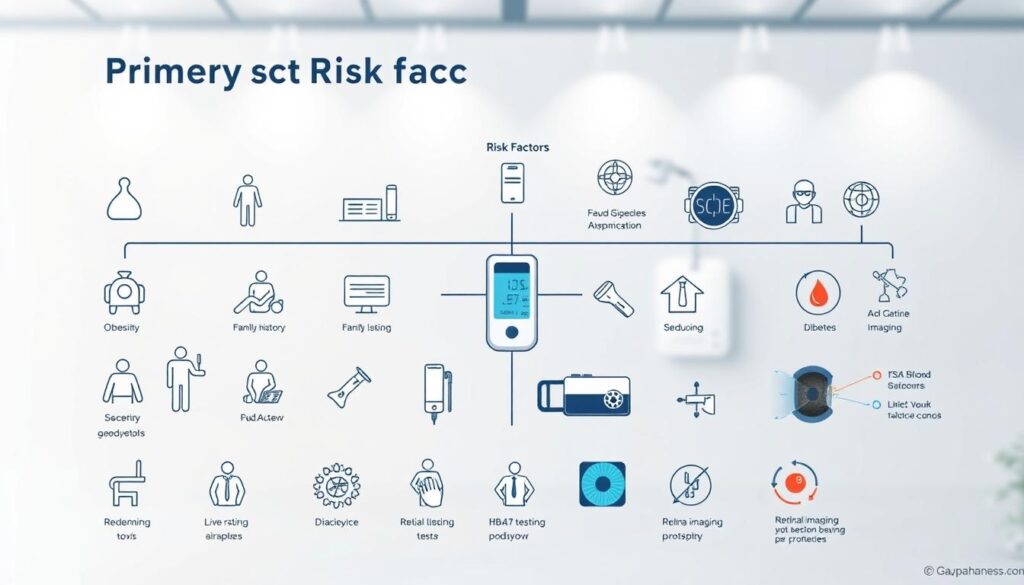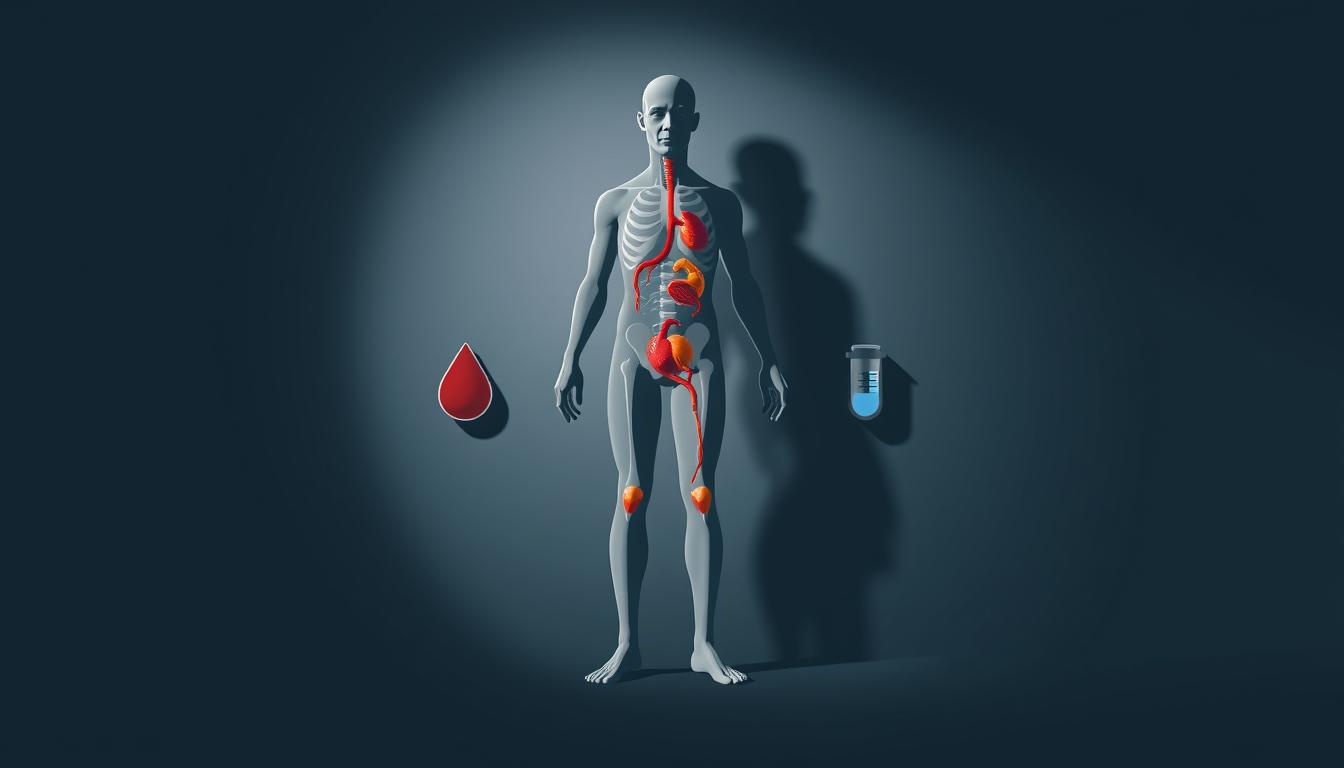Diabetes: 10 Key Signs You Should Never Ignore
Table of Contents
Living with undiagnosed diabetes is like walking through a silent minefield. Your body sends subtle signals that something is off. But you might not catch them until serious problems show up. Nearly 39 million Americans are dealing with this, with 8.7 million cases still not found.
Knowing the warning signs of diabetes is key to protecting your health. Insulin resistance and high blood sugar can quietly harm your well-being. They can do so before you even notice something’s wrong.
This guide will show you the important signs your body might be sending. It’s about taking charge of your health and making smart choices. Whether you’re noticing strange symptoms or just want to stay ahead, spotting these signs could be your first step to prevention and management.
Key Takeaways
- Diabetes affects nearly 39 million people in the United States
- 8.7 million cases remain undiagnosed
- Early detection can prevent serious health complications
- Insulin resistance can develop without obvious symptoms
- Regular health screenings are crucial for managing diabetes risk
Understanding Diabetes and Its Impact on Health
Diabetes is a complex metabolic disorder that affects millions of Americans. It challenges their glucose monitoring and overall health management. This chronic condition disrupts how your body processes glucose, leading to serious health complications if left unchecked.
What Exactly is Diabetes?
Diabetes is a metabolic disease with high blood sugar levels. Your body either doesn’t produce enough insulin or can’t use it well. This prevents cells from absorbing glucose, causing sugar to build up in your bloodstream.
Types of Diabetes
Understanding the different types of diabetes is crucial for effective management:
- Type 1 Diabetes: An autoimmune condition where the pancreas produces little to no insulin
- Type 2 Diabetes: The most common form, typically developing in adults due to insulin resistance
- Gestational Diabetes: Occurs during pregnancy and may increase future diabetes risk
Growing Prevalence in the United States
The diabetes landscape in the United States is alarming. Recent CDC data shows that about 1 in 3 adults have prediabetes, with more than 80% unaware. In the last two decades, adult diabetes diagnoses have more than doubled.
Approximately 38 million Americans are living with diabetes, and 1 in 5 remain undiagnosed.
Type 2 diabetes makes up 90-95% of all diagnosed cases. This widespread health challenge highlights the need for awareness, early detection, and proactive diabetes management strategies.
Common Warning Signs of High Blood Sugar
Knowing the early signs of high blood sugar is key to staying healthy. High blood sugar doesn’t always show up in big ways. But, your body gives you small clues that something’s off.
There are several important symptoms to watch for:
- Extreme Thirst: When your blood sugar is high, your body tries to get rid of extra glucose by making more urine.
- Frequent Urination: Going to the bathroom more than 7-10 times a day could mean a problem.
- Unexplained Fatigue: Your body has trouble turning glucose into energy.
- Blurry Vision: High blood sugar can make your eye’s lens shape change temporarily.
- Slow-Healing Wounds: High glucose levels make it harder for your body to heal.
Diabetic symptoms can sneak up on you. About 90-95% of people with type 2 diabetes have high blood sugar. Young adults and kids might notice these signs faster, sometimes in just weeks.
Listen to your body’s signals – catching it early can stop big problems.
If you’re seeing many of these signs, see a doctor. They can check your glucose levels and help you control them. Knowing your body’s warning signs is the first step to staying healthy.
Silent Symptoms That Require Attention
Diabetes can show itself in small ways that are easy to miss. It’s important to know these signs to catch diabetes early. Your body is always trying to tell you something.

High blood sugar can cause unexpected changes in your body. These signs might seem small, but they can mean big health problems.
Skin-Related Changes
Your skin can tell a lot about your health. About half of people with insulin resistance get acanthosis nigricans. This is dark, velvety patches in skin folds.
- Persistent skin itching
- Slow-healing wounds
- Unusual skin discoloration
- Repeated skin infections
Digestive System Signs
Diabetes can affect your digestive system in surprising ways. About 30% of people with prediabetes have digestive problems that show metabolic issues.
| Digestive Symptom | Potential Indication |
|---|---|
| Frequent infections | Compromised immune response |
| Unexplained nausea | Nerve damage affecting digestion |
| Irregular bowel movements | Metabolic system disruption |
Neurological Indicators
Nerve damage from high blood sugar can cause scary symptoms. 10% to 20% of people notice nerve-related signs.
- Tingling sensations in hands and feet
- Numbness in extremities
- Unexplained pain
- Reduced sensation
Seeing your doctor regularly is key to catching these signs early. If you keep getting symptoms, talk to your doctor. They can check if you’re at risk for diabetes problems.
Understanding Diabetes-Related Complications

Diabetes can lead to serious health problems that affect many parts of the body. If you don’t keep track of your glucose levels, you’re at higher risk for long-term health issues.
Diabetic complications can harm important organs and functions. These include:
- Cardiovascular system
- Kidney function
- Nervous system
- Vision and eye health
- Skin and wound healing
Your heart health is a big concern. People with diabetes are 2 to 4 times more likely to get heart disease or stroke. High blood sugar can cause heart problems and damage blood vessels.
Nerve damage is another big worry. Diabetic neuropathy affects 60-70% of diabetes patients. It causes numbness, pain, and can lead to serious foot problems.
Kidney health is also at risk. About 1 in 3 adults with diabetes gets chronic kidney disease. High blood sugar can severely damage the kidneys, which filter blood.
Keeping your glucose levels in check and living a healthy lifestyle are key. Regular doctor visits, managing your blood sugar, and following your treatment plan can lower your risk of these serious problems.
Risk Factors and Early Detection Methods
Knowing the risk factors for diabetes is key to early detection and prevention. Your health journey starts with understanding the elements that lead to insulin resistance and diabetes.

Diabetes doesn’t happen suddenly. Many factors can increase your risk of getting this complex metabolic condition.
Genetic Predisposition
Your family history is a big factor in diabetes risk. Studies show people with a family history of type 2 diabetes are 2-3 times more likely to get it.
- White populations show higher type 1 diabetes prevalence
- Certain ethnic groups face increased diabetes risks
- Genetic factors can predispose you to insulin resistance
Lifestyle Factors
Your daily choices greatly affect diabetes risk. Being active, eating right, and keeping a healthy weight are key to monitoring glucose and preventing diabetes.
| Risk Factor | Impact |
|---|---|
| Physical Inactivity | Less than 3 times weekly exercise increases risk |
| Obesity | Over 80% of type 2 diabetes patients are overweight |
| Age | Increased risk after age 45 |
Testing and Diagnosis
Regular screening is your best defense against undetected diabetes. About 50% of adults with diabetes don’t know they have it.
- Fasting Plasma Glucose Test
- Oral Glucose Tolerance Test
- A1c Blood Test
Early detection through glucose monitoring can cut cardiovascular disease risk by up to 50%. Don’t wait—talk to your healthcare provider about the right screening for you.
Managing Blood Sugar Levels
Managing diabetes well means controlling your blood sugar levels. It’s important to know how to check and keep them in check. This can really help you live better with diabetes.
Here are some important ways to manage blood sugar:
- Regular blood glucose monitoring
- Balanced nutrition planning
- Consistent physical activity
- Medication management
Setting blood sugar targets is key. Typical blood sugar ranges include:
| Time of Measurement | Target Blood Sugar Level |
|---|---|
| Before Meals | 80-130 mg/dL |
| Two Hours After Meals | Less than 180 mg/dL |
Your diabetes plan should fit you. People with type 1 or type 2 diabetes might need to check their blood sugar often. The American Diabetes Association suggests keeping your A1C level under 7%.
Exercise is very important for controlling blood sugar. Try to do at least 150 minutes of exercise each week. This can make your body use insulin better and keep your blood sugar stable. Also, losing weight, even just 5%, can help control blood sugar.
What you eat is also very important. Here are some tips for your diet:
- Count carbohydrate intake
- Choose low glycemic index foods
- Increase fiber consumption
- Stay hydrated
Consistency is the key to successful diabetes management.
Prevention Strategies and Lifestyle Changes
Managing your health is key in diabetes care. Studies show that making lifestyle changes can cut type 2 diabetes risk by half. Your efforts can greatly improve your health over time.
To prevent diabetes, you need a plan that covers many areas of your life. These steps can help a lot with your diet and health.
Dietary Guidelines for Diabetes Prevention
Eating right is vital for controlling blood sugar. Here are some important diet tips:
- Eat more whole grains and complex carbs
- Add lean proteins to every meal
- Choose veggies with a low glycemic index
- Reduce processed foods and sugars
Physical Activity Recommendations
Exercise is a big help in managing diabetes. The CDC suggests:
- Do 150 minutes of moderate exercise a week
- Do strength training twice a week
- Stay active and avoid sitting too much
Stress Management Techniques
Too much stress can hurt your blood sugar. Try these ways to reduce stress:
- Try meditation every day
- Exercise regularly
- Keep a regular sleep schedule
- Stay connected with friends and family
| Lifestyle Factor | Potential Impact |
|---|---|
| Weight Loss | 50% reduction in diabetes risk |
| Regular Exercise | Improved insulin sensitivity |
| Balanced Diet | Better blood sugar control |
| Stress Management | Reduced hormonal disruptions |
Remember, small consistent changes can lead to significant health improvements in diabetes prevention and management.
When to Seek Medical Help
Knowing when to get medical help is key to managing diabetes well. If you keep losing weight, pee a lot, or feel very tired, see your doctor. Checking your blood sugar often is important for catching diabetes early.
People over 45 or who are overweight should get tested for diabetes often. With 29.3 million adults diagnosed and 9 million not knowing, early testing can save lives. Your doctor might do tests to see if you’re at risk for diabetes.
Watch out for signs like very high blood sugar, over 240 mg/dL, which means you need to see a doctor right away. Don’t ignore symptoms like bad stomach pain, trouble breathing, or signs of infection. Diabetes can make it hard for your body to heal, so getting help quickly is crucial.
Managing diabetes well means talking often with your healthcare team. Regular visits, keeping track of your blood sugar, and following your doctor’s advice can greatly improve your health and life quality.
FAQ
What exactly is diabetes?
Diabetes is a long-term condition where your blood sugar levels are too high. This happens because your body can’t make or use insulin well. It affects how your body uses glucose, leading to health problems if not managed.
What are the different types of diabetes?
There are three main types of diabetes. Type 1 is when your body doesn’t make insulin. Type 2 is when your body can’t use insulin well. Gestational diabetes happens during pregnancy.
What are the most common symptoms of diabetes?
Symptoms include needing to pee a lot, feeling very thirsty, and losing weight without trying. You might also have blurred vision, feel tired, and have slow-healing wounds. If you notice these signs, see a doctor right away.
How can I monitor my blood sugar levels?
You can check your blood sugar with glucose meters or CGM systems. Blood tests like the HbA1c test also help. Regular checks show how diet, exercise, and medicine affect your sugar levels.
Can diabetes be prevented?
Some risks, like family history, can’t be changed. But, you can lower your risk with lifestyle changes. Eat well, stay active, manage stress, and keep a healthy weight.
What long-term complications can diabetes cause?
If diabetes isn’t controlled, it can cause serious problems. These include heart disease, kidney damage, nerve damage, vision issues, and a higher risk of infections and slow healing.
How does diet impact diabetes management?
Eating right is key to managing diabetes. Eat whole grains, lean proteins, and lots of veggies. Avoid processed foods, sugary drinks, and too many carbs to keep your blood sugar stable.
When should I see a doctor about potential diabetes?
See a doctor if you keep feeling thirsty, pee a lot, or lose weight without trying. Also, if you have risk factors like family history, being overweight, or not being active.
Can diabetes be cured?
There’s no permanent cure for diabetes. But, Type 2 can be managed and even reversed with the right lifestyle, weight control, and treatment.
How does stress affect diabetes?
Stress can raise your blood sugar by releasing stress hormones like cortisol. To manage diabetes, it’s important to find ways to reduce stress, like meditation, exercise, and getting enough sleep.







